To celebrate the week of Earth Day, we explore Sepilok, a centre in Malaysian Borneo where orphaned and injured orangutans are rescued and cared for.
My first encounter with an orangutan was a magical one. I was in Singapore Zoo, where free ranging orang utans are kept. It was the hottest time of the day, humid as hell, the sky was grey and thick with clouds. A downpour was on its way. Most visitors had retreated to the zoo’s restaurants and cafés, but I didn’t want to miss the chance of wandering around on my own. Suddenly, I heard leaves rustle just above my head. I raised my eyes and saw an orangutan, wrapped around a wire between two trees.
He looked at me, I looked back. He had such lovely, inquisitive eyes. The forlorn look of an old man, the curiosity of a little kid. He had a touch of shyness about him. We shared a look for a while, and then I raised my hand and waved at him. He waved back, then disappeared.
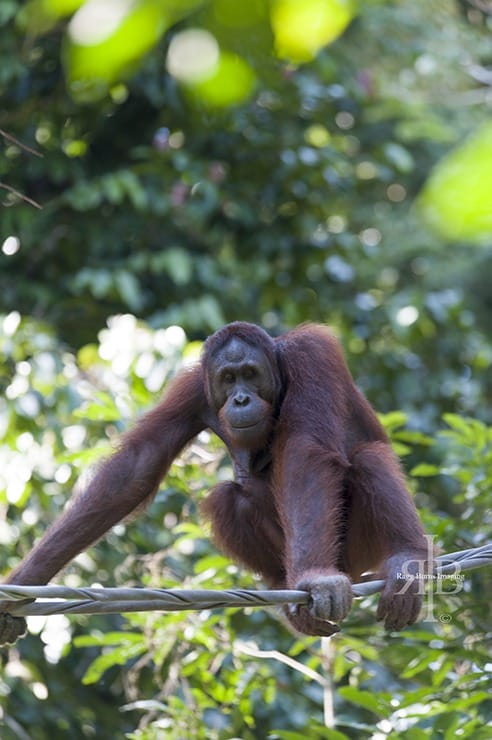
Travelling around South East Asia, orangutan news are on every other newspaper. Baby orangs killed by poachers. Orangs rescued from homes in inhumane conditions. I once shivered reading about a young orangutan addicted to alcohol and cigarettes that was kept as a pet by an elderly Indonesian man. I even saw orangutans for sale with my own eyes, in the darkest recesses of Bangkok Chatuchak Market.
Orangutans once inhabited the whole of Borneo. Agnes Keith, in her book Land Below the Wind, talks of orangutans visiting her garden. After the palm oil boom in the Sixties, much of Borneo has been logged to make room for palm oil plantations. About 80 per cent of orangutan habitat has been destroyed; numbers have decreased from several hundred thousand to just over 40 thousand. National Geographic has estimated they may be extinct by 2023.
Sepilok Orangutan Rehabilitation Centre, located 25 kilometers out of Sandakan, opened in 1964. Resident orangutans were orphaned and rescued after their mothers had been killed by poachers. Some were found injured in the forest, others again were rescued from homes where they were kept illegally.
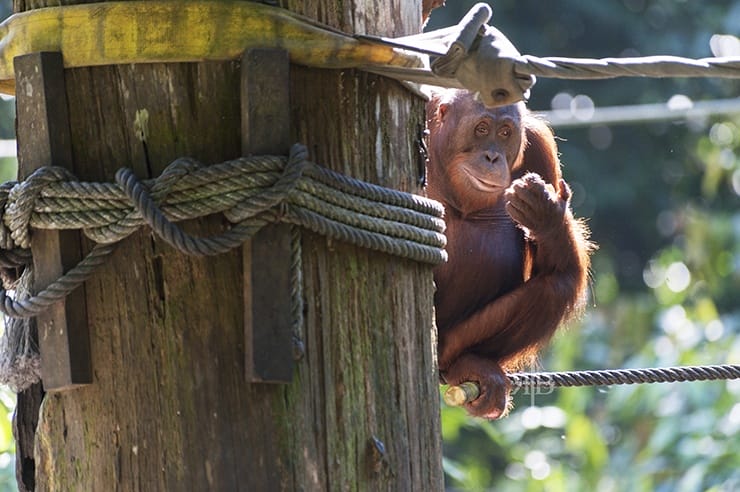
Orangutans are kept at Sepilok until they are healthy and have developed the skills to live independently. The centre sits in the middle of 43 km2 of protected forest; a large enough area for orangs to live comfortably. Many orangutans, especially those who arrived as babies, spend most of their lives around Sepilok, even after they have been released.
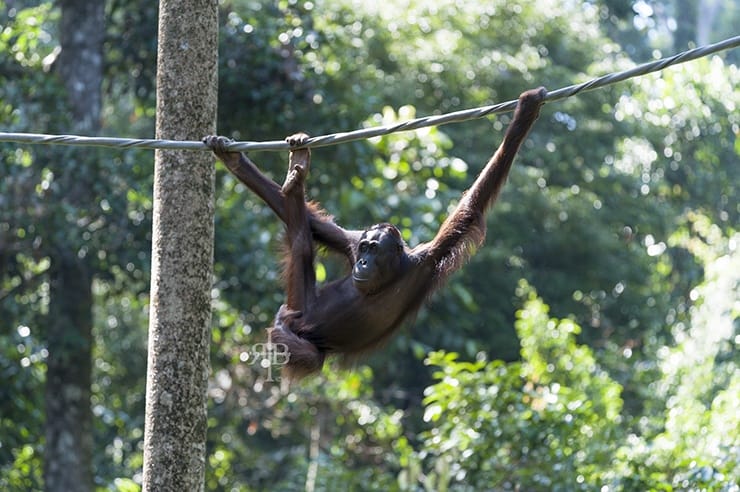
It is not possible to visit the centre where the injured orangs are kept. However, you can see orangutans every day, at 10 and 3 pm, at the feeding platform. At this stage, orangutans are free, so there’s no guarantee they will actually turn up. It is very hard not to have a sighting, we were told.
The feeding platform sits at the end of a boardwalk, ten minutes or so from the reception area. We visited in the afternoon; at about 3.30, the platform was packed with dozens of visitors, anxiously scanning the leaves above for a glimpse of orange-brown fur.
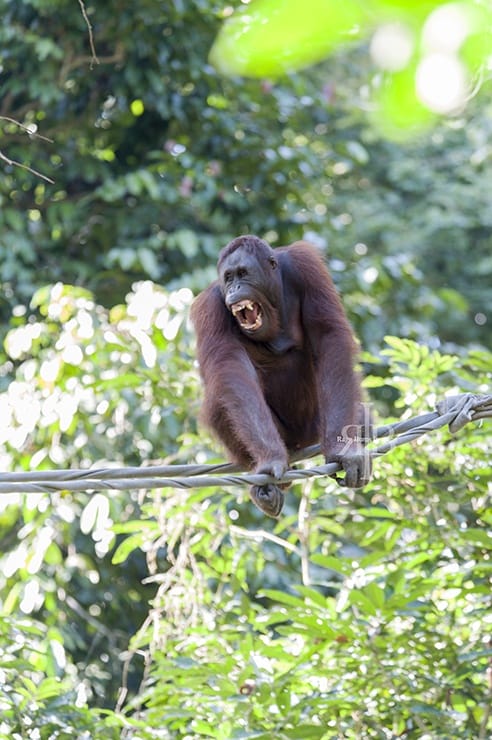
After a little while, we heard a ‘thump’. The ropes between the trees and the feeding platform wobbled, and the first orangutan appeared. He was an older individual, his fur so dark it looked almost maroon. He moved slowly but carefully, measuring his steps. He stopped in front of a fruit basket, and picked a banana.
The, he started to peel it. The same movements I make every day. Snap the top. Peel, one, two, three strips. Bite.
I knew orang utan is Malay for ‘men of the forest’. I knew they share 98 per cent of their genes with us. But it was there, looking at an orangutan eating a banana, that I realised how similar they are to us.
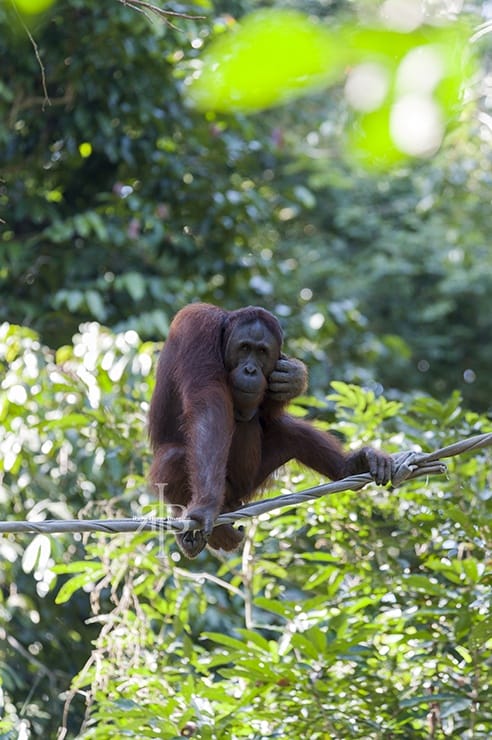
With the realisation, came the anger. I was angry with my fellow men, who day after day fell century-old forest to chase the quick buck of palm oil, driving orangutans into the last remaining patches of forest. Loss of habitat is the first reason for their dwindling numbers; if nothing is done, they may indeed disappear very soon.

Another orangutan appeared shortly afterwards. He was smaller and scruffier-looking, a bit like a teenager. By then, no one said a word. Dozens of eyes scanned their movements, as they ate one fruit after another. Then, just as suddenly as they appeared, they left. I stood in my tracks for a second, trying to take in what I had just witnessed. A moment that is now one of my most precious memories.
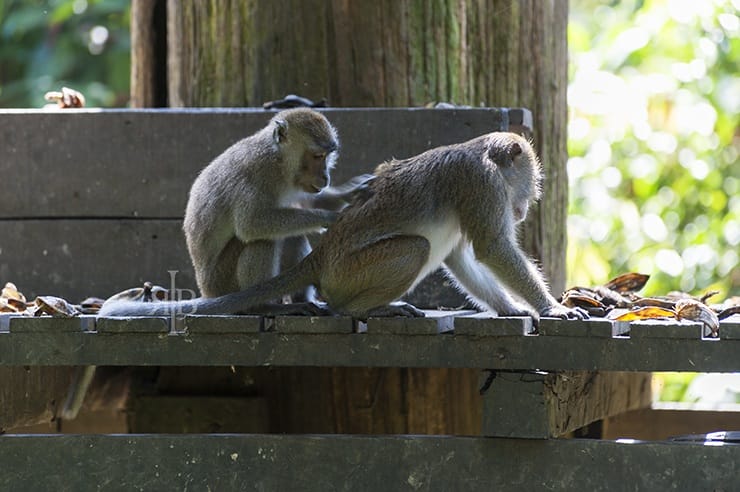
Practical Information about Sepilok
Sepilok Orangutan Rehabilitation Centre is located in a forested area 25 kilometers out of Sandakan, in the Malaysian state of Sabah. The centre is open Saturday to Thursday 9am to 12pm and 2pm to 4pm; Friday 9am to 11am and 2pm to 4pm. Feeding times are 10am and 3 pm daily. Tickets costs RM 30 plus RM 10 for camera permit.

What an amazing experience to see the orangutans up close!
It was great! Visit if you get a chance!
It is incredibly sad that the Rehabilitation Center needs to exist because of the cruelty of man, but I’m glad these orphaned orangutans get a second chance at life. I hope companies start being more responsible about the palm oil that they source and the forests still exist for these amazing animals. Let’s hope the 2023 prediction is very far off!
Hey Jen, true, let’s hope the future for orangutans will be brighter. Still, the work rehabilitation centres are doing is really fantastic.
Wow those photos are incredible! What an amazing experience – you’re so lucky!!
It was indeed. one of our favourites so far! Thanks for your comment Emily!
Sounds so interesting walking with and watching these guys. Seems like you had a great time!
It was amazing. We love orangutans! Don’t miss visiting them in Borneo if you get a chance!
Some lovely pictures of orang-utans here. It’s good to know that people are working so hard to save them.
Great work sharing about Orangs, Deforestation and poaching are worst crimes and it is same here in Nepal too. But I see a light of hope after this news http://news.nationalgeographic.com/news/2014/03/140312-nepal-chitwan-national-park-wildlife-poaching-world/ (Zero poaching year). I hope it is the same with them Orangs.
Thanks for sharing this story. It makes me sad especially because I had an experience too in Laos with a monkey and a bird. I wrote about it on my website (The Sad Story Of Mr. Monkey And Mrs. Bird). It´s horrible how humans treat animals. At least some try to rescue animals…
It’s amazing how similar they are to us! You got some great shots of the orangs. Hopefully conservation efforts will step up to ensure these men are around for a bit longer.
Men of the forest! This is really cool! I didn´t know they share 98 % of their genes with us. Now I understand why people I met in Malaysia were so excited after seeing the orangutans :))
What a lovely creatures orangutans are! I didn’t know the origin of the word orang utan – thanks for teaching! They really do look so similar to humans. That second photo in the post says it all. We, as people, can be really cruel. It makes me sad.
Such majestic creatures, such lovely pictures, such a lovely post!
Ah love it! What amazing photos, and what a privilege to have been able to spend time with these amazing creatures. So jealous! 🙂 x
As always great photography :)! It’s indeed incredibly sad that those poor animals are driven away from their territories by ‘mankind’, but it is also encouraging to know that there also people who fight against and try to save them!
It’s sad this place was born out of cruelty, but it seems what they’re doing now is positive. I’d love to see the orangutans up close!
This is why I love blogging so much, someone else sharing such a memorable experience with others who may never get to experience it for themselves. I loved hearing your thoughts and the pictures are fantastic, I felt like I was right there with you. It’s always sad to think of any animal becoming extinct no matter the reason.
They’re such wonderful animals, aren’t they!? I had to smile when I read how you’d waved at one and he waved back. The Sepilok Sanctuary is one I wish I’d known about earlier… Id been looking for organisations with a wildlife focus to do an international internship with earlier this yeah. Oh well, these things happen. Likely they wouldn’t have been able to take me anyway.
Wonderful post! My boyfriend loves Orangutans and would really like to experience an encounter like this. Thanks for all the wonderful information, it sounds like you had a life changing day 🙂
It was really a fantastic day, and I didn’t realise how much the experience had touched me for a long time. Sometimes, when you write you travel for the second time!
Great pictures! I love all the little captions under the pictures. Its a shame these animals are mistreated. Whenever I travel I make an effort not to contribute money to any street performers with animals as this makes me feel as if I am contributing to the prolonged suffering of the animal.
Great photos and a fantastic write up. I cannot imagine seeing orangutans for sale at a market. That’s so very sad. I would have wanted to rescue them all, but of course, what would I actually do with them once I bought them? I visited a similar orangutan rescue centre on the other side of Borneo in Sarawak. It was also a very memorable experience for me. (Your photos are much better than mine.)
Thanks for sharing these wonderful pictures!
Meeting the men of the forest – I love the origin of the name. It’s pretty remarkable that we’re only 2% different from them and that there are many similar characteristics. I think I would have been thrilled if an orangutan waved back at me. So cool!
Love this! I’ll be going here on my upcoming trip and I can NOT wait. Amazing photos as well! Thanks for linking up to the #SundayTraveler 🙂
Tragic actually…
Amazing!! I went here too last year and loved these little guys! Your pictures are MUCH better than mine here though!! http://wp.me/p3Lian-cp
Thanks for your comment guys, glad you liked the pics! It’s an amazing place, isn’t it!
I loved seeing all the orangutans you featured here with the cutest captions. I have heard of this rehab centre and despite its origin and reason of existence, it may also inspire people to be aware of the orangutans’ plight. I didn’t know about the Malay word for ‘men of the forest’. Very interesting! What a great experience for you.
Thanks Mary. I’m glad you liked the post. It was a wonderful experience!
What a fabulous experience! The teeth on that old guy gave me a fright – I’d hate to upset him and be too close! Biggest thanks for joining us for #SundayTraveler this week.
Thanks SJ! It was an amazing experience!
You are definitely right Margherita, orangutans are really incredible creatures. I was fortunate enough to see them in Bukit Lawang on Sumatra and they too have a feeding platform for these semi-wild apes. We even saw some wild ones further in the jungle and I was simply fascinated by the way they looked and moved about. This really was an unforgettable experience for me and I can only hope that the estimates of National Geographic will turn out untrue…
Hey Dennis! I would love to visit the Sumatran cousins, I have heard lots of good things about the place. Thanks for your comment!
Thank you for your nice words John. Glad you loved my posts, hope I won’t disappoint you in the future!
It’s such a lovely place, and the work they’re doing is amazing. Thanks for your comment!